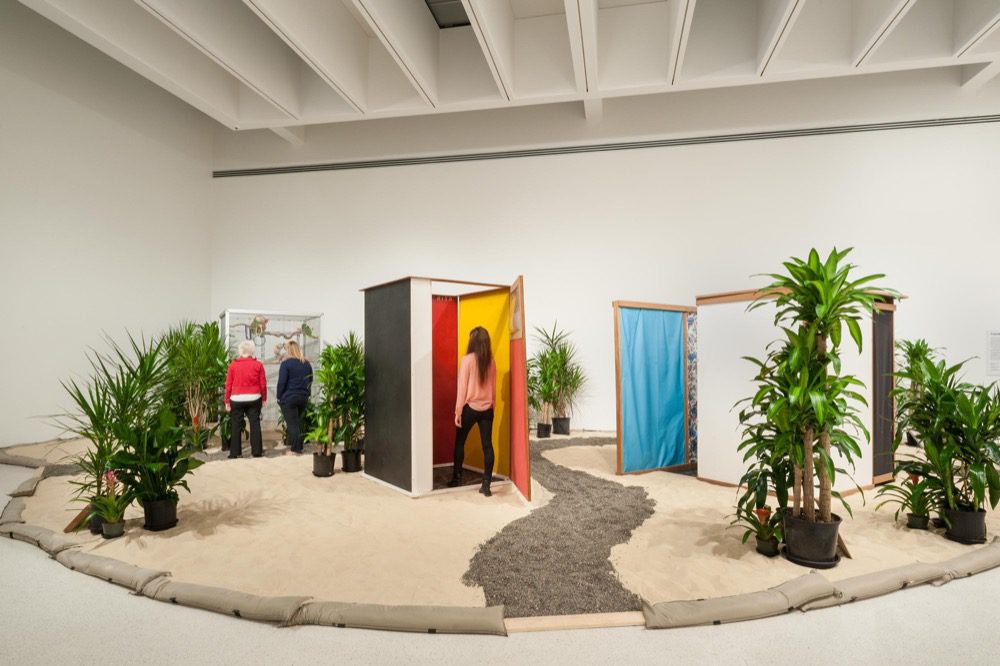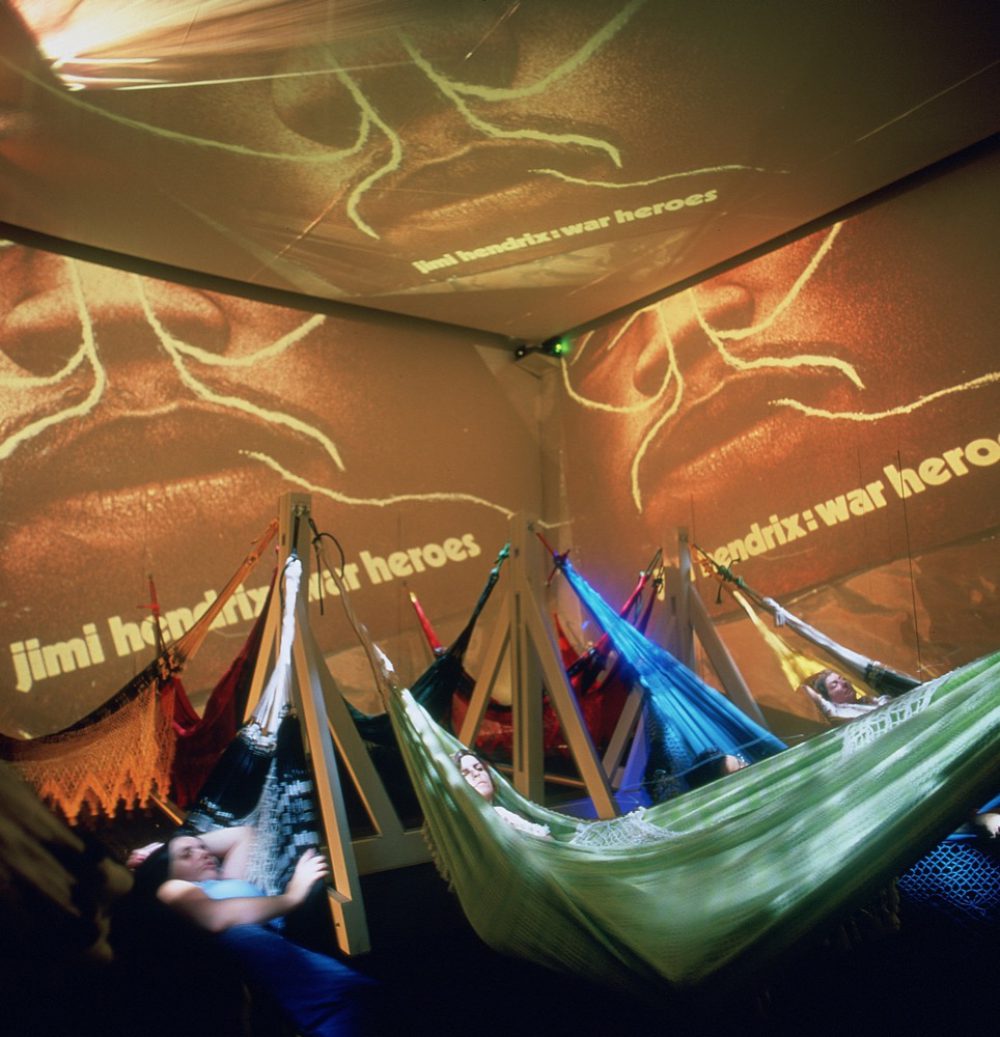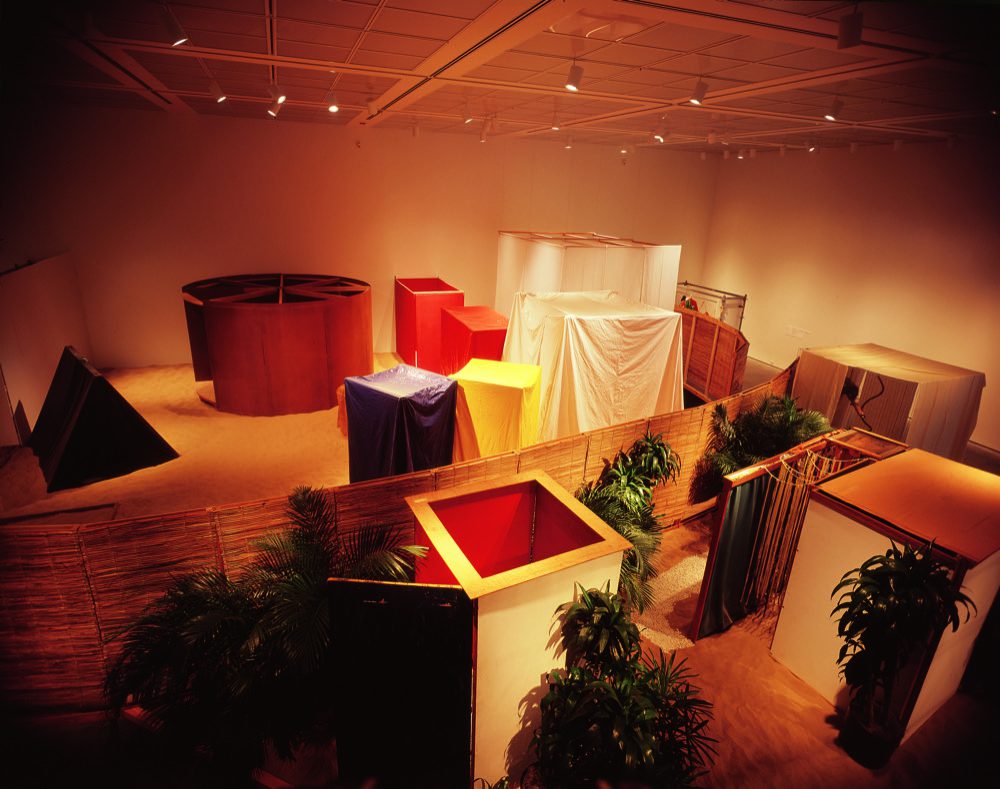Hélio Oiticica’s Underground Order
Adrian Anagnost looks at how Hélio Oiticica’s canonical practice has been received over time in Brazil and the United States.

Installation view of Hélio Oiticica’s Tropicália, PN2, and PN3, 1967, at the Carnegie Museum of Art, Pittsburgh. Courtesy the estate of Hélio Oiticica.
Hélio Oiticica’s louche and immersive “quasi-cinema” Cosmococa 5 Hendrix-War, 1973—produced in collaboration with filmmaker Neville D’Almeida—was certainly the queerest space in his recent retrospective, held at the Carnegie Museum of Art in Pittsburgh, the Art Institute of Chicago, and the Whitney Museum of American Art in New York in 2016 and 2017. CC5 Hendrix-War takes the form of a darkened room, illuminated solely with slide projections, most visibly a photograph of Jimi Hendrix’s LP War Heroes ornamented with designs traced out in cocaine. The space is suffused with the powerful sonic distortion of Hendrix’s guitar, with hammocks inviting visitors to lie down and enter a multi-sensory vivência [experience]. This is a classic Oiticica move, to create an aesthetic environment that induces heightened embodiment as artwork. Rather than a tropicalist gesture of liberatory intimacy—as Oiticica’s earlier participatory Parangolé garment sculptures have been interpreted—this strategy is rooted squarely in 1970s New York, where the artist was living in semi-exile while an authoritarian military regime reigned back in his home country of Brazil.
With its references to rock music and drug use, CC5 has something of New York’s glamor and grime of that era, albeit filtered through Oiticica’s artistic formation in Brazil and his pivotal year in London just before coming to the United States in 1970. Sleeping hammocks are a staple of northeastern Brazilian culture (anthropologist Luís da Câmara Cascudo wrote a 1957 ethnographic study of the hammock in Brazil), while the room’s psychedelic intensity evokes swinging ’60s London. But Oiticica’s turn to what he called “quasi-cinema” is quintessentially New York. As art historian Julia Bryan-Wilson has described of the slightly later West Hollywood “queer microcinema” scene, Oiticica’s Cosmococas rejected the formalized collectivity of museum galleries (the “neutral” space of the white cube) or the quiet and orderly darkness imagined as the appropriate setting for mainstream film viewing. At that time, New York was a city of queer and underground cinema, of intimate, ersatz art spaces where getting together with friends for a drug-fueled music-listening session could become (or be considered) art.

Installation view of Hélio Oiticica and Neville D’Almeida’s Cosmococa 5 Hendrix-War, 1973, at the Pinacoteca do Estado de São Paulo. Courtesy the estate of Hélio Oiticica.
Tropical Tensions
But even before New York, before his pivotal encounter with radical underground filmmaker Jack Smith, Oiticica had been working through conceptions of corporeal intimacy and spatial construction. Most famously, there are Oiticica’s Parangolés, cape-like, sculptural garments constructed from heterogenous materials—sheets of plastic, burlap panels, twisted skeins of brightly-colored cloth, aromatic sachets, coiled rope, a bouncy ball. As architecture on the body, or architecture of the body, these Parangolés drew upon the costumes and conviviality of Brazilian Carnaval, as well as the motley constructions of Rio de Janeiro’s favelas. For Oiticica, the Parangolés were intended to be worn while in movement, with participants continuously trading roles in a “watching-wearing cycle.” As art historian Irene Small has noted, the Parangolés thus participated in a queering of social interactions, creating a sort of “sensorial mating” that refused to allow participants to settle into a singular role (watching or wearing) or a singular formal configuration.
It’s crucial to mention that the Parangolés were created in Brazil, for Brazilian audiences, with much of their intelligibility reliant upon familiarity with aesthetic forms and social codes built up around Brazilian Carnaval. The Parangolés are perhaps best known for their institutional rejection in 1965, when Oiticica invited musicians and dancers from the samba school of Mangueira favela to activate his Parangolés for the exhibition “Opinião 65” at the Rio de Janeiro Museum of Modern Art (MAM Rio). The festive performers garbed in Parangolés were turned away at the doors of the museum. Contrary to foreign images of Brazil as a perpetual party, the staid norms of behavior governing the elite art space did not accommodate the rowdier sambistas. And, not coincidentally, the sambistas were predominantly Afro-Brazilian and working class, in contrast to the wealthier, predominantly white Brazilian museumgoers inside. This rejection of the Parangolés has inscribed Oiticica’s work into an avant-garde history of aesthetic rejection and belated valorization. But it is also part of a social history of continuing class and racial divides in Brazil.

Installation view of Hélio Oiticica’s Eden, 1969, at the Museum of Contemporary Art, Chicago. Courtesy the estate of Hélio Oiticica.
Controlled Environments
Before leaving Brazil in 1969, Oiticica turned his gaze outward, and his Tropicália, 1967, and Eden, 1969, environments together show his thinking about audiences both local and international, part of his efforts to combine avant-garde aesthetics with a Brazilian sensibility. Tropicália is thus a sort of parody of Brazilian stereotypes for a Brazilian audience, an in-joke in which viewers traverse sand and gravel paths through favela-like cabins called Penetráveis [Penetrables], encounter a couple of live macaws, brush past potted tropical plants, and listen to Caetano Veloso’s canonical song “Tropicália”—itself a parodistic and sharply critical invocation of Brazilian mulatas, Carmen Miranda, and soaring paper monuments rising above the corpses of children. Within Oiticica’s environment, the central Penetrável contains a staticky television set to a local station, a mediated emblem of modernity within the bare-bones constructions of sand and gravel. Eden, however, was pitched to an international audience, with its first exhibition at Whitechapel Gallery in London in 1969. The structure loosely resembles that of Tropicália, in that there are areas of sand and straw, and Penetráveis. While Eden’s spiraling construction still evokes favela architecture, “nests” of books and grass, Penetráveis with puddle-like pools of water, an all-too-erotic “bed” structure, and a nearby pool table led some London reviewers to pan the exhibition as a mere fun house. The references were no longer so local.
It’s difficult to recreate these environments in a contemporary show—half a century later in the United States—and something is lost—queerness, play, geographic specificity—by moving from underground into the canon. The heaped gravel, pits of straw, pools of water, and live birds scream litigation to museum legal departments, and that wariness shows. But still there was something else characteristically Brazilian about visiting Oiticica’s retrospective exhibition: the hovering presence of museum guards and exhibition interpreters. Despite stereotypes of Brazilian conviviality and tropical playfulness, prevalent social inequities mean that behavior is highly policed in much purportedly public space in Brazil, with classism, racism, and colorism shaping access to commercial and leisure spaces more overtly than in many U.S. settings. Over the past half decade, for example, groups of working-class teens of color have been prevented from entering heavily guarded Brazilian malls, paralleling the experience of the Parangolé-wearers at MAM Rio 50 years before. The U.S. museums were not so heavy handed, but play is limited under the monitors’ watchful eyes, a surveillance certainly of our own time. If Oiticica’s works still feel subversive, perhaps this results from our own nostalgia for 1960s-era dreams of ludic emancipation, for the bygone innocence of play as politics before the contemporary pervasiveness of—and sometimes acquiescence to—widespread social control. Or, less pessimistically, perhaps Modern Art’s canonization has not yet fully neutralized the underground.
Editor's Note
Hélio Oiticica’s “To Organize Delirium” was most recently on view July 14–October 1, 2017, at the Whitney Museum of American Art (99 Gansevoort Street) in New York.



